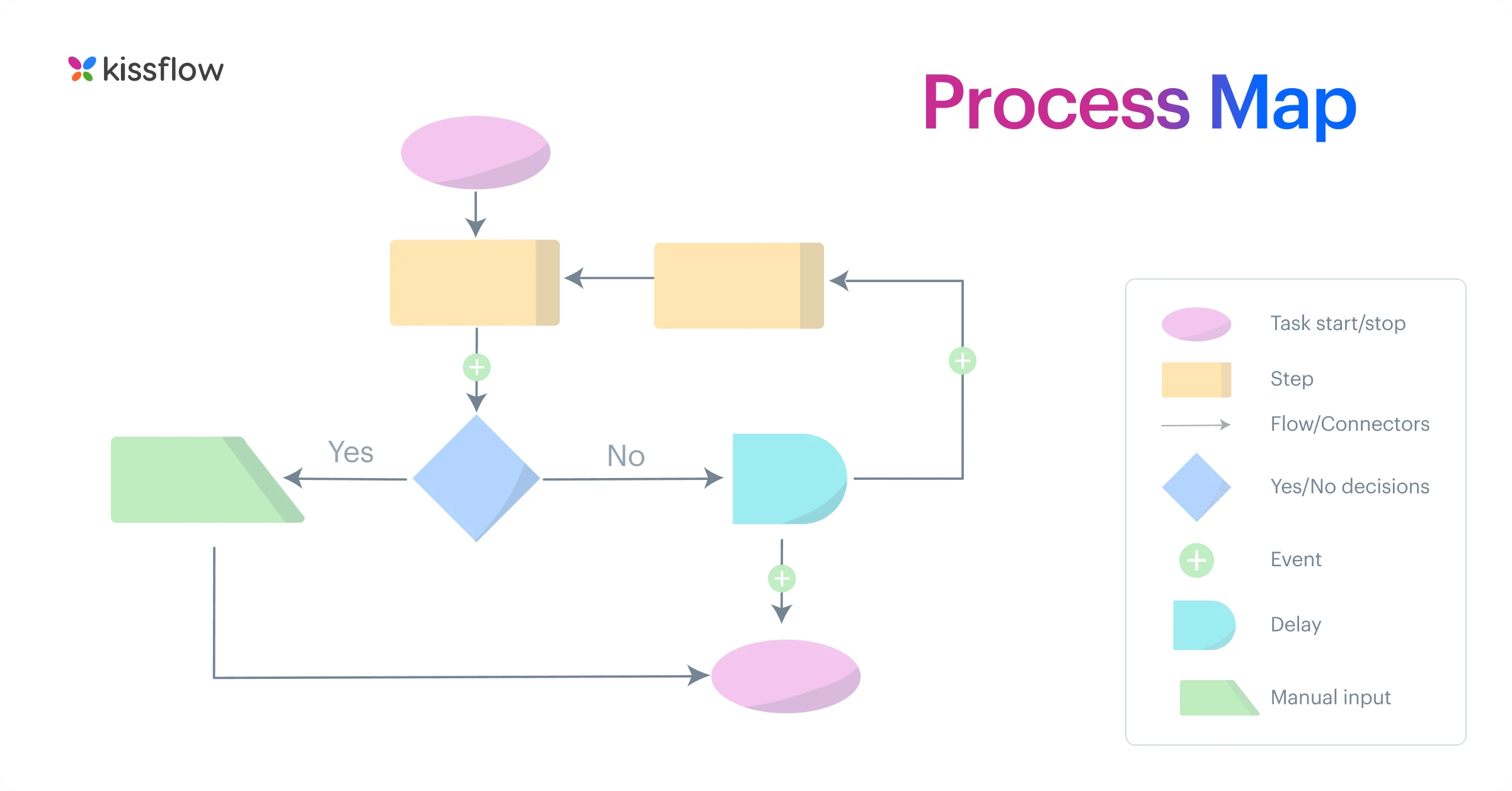
- >
- BPM Software >
- Process Improvement Techniques and Methodologies For Enterprise Businesses
Process Improvement Techniques and Methodologies For Enterprise Businesses
Team Kissflow
Updated on 22 May 2025 • 9 min read
No matter how smoothly you believe your enterprise is operating right now, there is always potential to do better.
When CIOs who want to steer their organization toward digital transformation focus on continuous process improvement, they can root out inefficiencies effectively and streamline internal business processes.
Process improvement techniques and methodologies allow businesses to constantly adapt to changing customer demands and market conditions.
So, What Exactly is Process Improvement?
Process improvement is a simple yet powerful idea. It is how businesses identify the parts of their business processes where they can increase their profit margins, cut down on expenditures, and speed up their operational timelines.
It’s not a radical or new concept–it was introduced by James Harrington as early on as 1991–but it’s especially important today.
There are a lot of methods and techniques through which a company identifies problem areas in their business processes. These process improvement techniques can analyze not only processes, but also design improvements that can help scale processes once the business grows larger.
Learn More: Business Process Management
Why You Need Process Improvement Today
Processes that run like clockwork can breathe life into your business (and profits), and ineffective processes can go so far as to kill your company. Even Bill Gates’ rule of thumb states that “A lousy process will consume ten times as many hours as the work itself requires.”
Inefficient processes lead to a waste of precious employees’ time

- The time that someone spends doing an unnecessary and redundant task could’ve been better spent in more valuable areas.
Working standards can drop
- Inefficiently built processes often mean that work becomes defective. Reports can go missing, deadlines can be missed, and employees can drop the ball in so many areas.
Productivity can take a hit
- The bottom line in any business is the finances, and productivity losses first hit this vital area. If you’re paying a team to do a job that could be easily automated, you’re literally losing money by the minute.
Besides these reasons, you’ll also want to stay ahead of radical improvements in technology, industry trends, and how your competition operates.
How Process Improvement Works
Business Process Improvement can work in two ways: it can flow through a structured path, or take a more informal route. Either way, though, it tends to follow four common steps.
1. Process Audits, And Finding Improvement Opportunities
- The audit is usually the best place to start process improvement efforts. Here’s what you should be looking for: opportunities to improve process, and potential risk areas. This will help you strategize business improvement, especially in regard to prioritizing specific areas.
- At this stage, it’s a good idea to get an understanding of how tweaking a particular process will impact resources, as well as stakeholders–which may be the organization itself, teams, individual employees, partner organizations, vendors, or customers.
2. Analyze Process That Are Currently in Use
- Once you’ve established which area you want to improve, spend time analyzing the processes that are in place. You can do this through process mapping (workflows), cause/effect studies, and operational surveys.
- Ask the right questions: Check if the process is broken, and where. Which steps cause delays/bottlenecks, and which ones are costly? Which steps cause quality losses?
3. Build Commitment and Support
- A commonly skipped step, and often the difference between a token effort and one that brings real change.
- Process improvement isn’t an instant do-over. It requires a dedicated commitment across the board, and that’s why getting senior management support is crucial. Managerial support will make the difference when you explain the change in the status quo, and why it is necessary.
- Improving processes takes a lot of time and resources, so make sure you get the all-important upper management approval and support.
4. Strategize Your Process Improvement Plan
- A good strategy will include the steps you’ve isolated as problem areas, why they are problem areas, and how you plan to improve them. Make sure that your process improvement objectives are realistic, measurable, and necessary in the context of your organization’s strategic long-term and short-term goals.

Unlock the Power of Comprehensive BPM Tools: Scale, Succeed, and Stay Ahead
Thank you for downlaoding!
Process Improvement Techniques:
Here are the 5 Process Improvement techniques:
- Process Maps
- Fishbone Diagrams
- Histogram Charts
- Scatter Diagrams
- Pareto Chart
The choice of process improvement technique is entirely dependent on the scope of improvement in the project. In each description, you’ll find a recommendation of where each one works best.
1. Process Maps

Also commonly called flowcharts, these diagrams are used to visually represent relationships and tasks that make up a process. In a process map, you typically start from the top and move downward, working from the initial task to the final one.
From the higher levels, you can get an understanding of the complexity of the process, thus ensuring that you have a macroscopic understanding of how the process works. At the bottom level, you’ll gain an understanding of how each individual task plays a part in the process.
Using a process map, you can easily chart out a complex process diagram to give you and your team clarity on how the process improvement will work.
Process maps are great when you’re designing actual processes on products like Kissflow Process, since these process maps can effectively be translated into real and applicable processes into the software.
2. Fishbone Diagrams
Fishbone diagrams are also known as Cause and Effect diagrams or Ishikawa diagrams. They’re techniques in determining problems and how they arise in a process. Typically done at the beginning of a Root Cause Analysis, fishbone diagrams help in finding out where a problem is and organizing the causes for a problem. This can include the people working on it, the methods that are used, the equipment that is currently used in the existing process, and the environment the process is running in.
Using the data that is gathered from this diagram, you can find out where a process is faulty or underperforming, and see where you need to make appropriate changes for process improvement.
Fishbone diagrams are a great tool for business process improvement, since they can be done entirely offline, and help teams that are working on process improvement find the core reason the process isn’t performing as required, or where the improvement needs to be done.
3. Histogram Charts
Histogram charts are another technique at your disposal when trying to make process improvement. They show the relationship of data between a variety of variables over time. This is particularly useful if you’re doing process improvement analysis.
You can find out how the process was performing at its peak. Using that, you can change different variables to see what was the cause for the performance increase, and alternatively, see what was the detriment to any performance decreases, and make note of the same for your process improvement.
Histogram charts don’t point out which part of the process needs improvement, but they’re useful in finding out which variables affect the performance. Using this, small changes can be made.
4. Scatter Diagrams
Scatter diagrams are another technique in process improvement analysis. They use current variables to establish the current pattern, and predicted variables to see how the process will perform. This is useful since you can see which changes give outcomes that are favorable, and avoid any changes that seem to give negative outputs.
Scatter diagrams are used in hypothesis testing. This helps you see if there is a direct correlation between variables and the end impact on performance. If the scattering is close together, it indicates a higher correlation. If the scattering is further apart, that indicates less correlation.
5. Pareto Chart
A Pareto chart is a ranking of defects, causes, and/or data in a process. They’re ranked from the most significant to the least significant. This kind of ranking helps in process improvement analysis, since you can filter out the major factors that need attention and the details that don’t affect the process much.
Using this data, you can channel your efforts into focusing on those factors that cause the greatest impact, while leaving the smaller details for a later time.
Four common process improvement strategies
Companies can use different types of process improvement strategies to reduce inefficiencies. The right strategy depends on what processes you want to improve and why you plan to improve them.
Modernize
Modernization involves migrating processes from redundant legacy systems to newer and more efficient modern platforms. At the simplest level, this can mean replacing traditional manual systems with digital alternatives. However, organizations that already utilize digital systems can further modernize by adopting next-generation tools—such as Business Process Management (BPM) tools—which offer enhanced features and benefits.
These tools facilitate streamlined workflows, improved integration capabilities, and advanced analytics, leading to reduced operational costs and higher returns on investment. By leveraging BPM tools, businesses can ensure their processes are aligned with current technological standards and are adaptable to future innovations.
Optimize
Optimizing processes as part of your process improvement strategy involves identifying areas with inefficiencies and fine-tuning them for better results. It is achieved by running data-backed ‘what-if’ scenarios to simulate how changes to various factors will affect the outcome of process. You continually experiment with varying resources, costs, team structure, and other factors until the best possible outcome is achieved.
Standardize
Standardizing processes involves making changes that drive consistency in process execution. It is achieved by establishing specific rules or conditions that have been tested, fine-tuned, and proven to deliver value.
Reusing these established standards for subsequent processes or applying the same standards across different departments helps maintain consistency in quality and output. Standardizing processes also reduces the need for continuous oversights and makes results more predictable.
Automate
Automation involves limiting or removing human inputs when executing processes. It is particularly effective for mundane and repeatable processes easily set on auto-pilot.
Removing human inputs from low-level tasks increases the speed and efficiency of processes and reduces the error margin. Automation also minimizes costs and frees employees’ time and efforts for higher-level functions.
Types of process improvement methodologies you should know about
Some of the main types of process improvement methodologies include:
Six Sigma methodology
Developed in 1986 by engineers at Motorola, the Six Sigma methodology is a process improvement framework that focuses on identifying defects or inconsistencies in processes and eliminating them to deliver the perfect products or services.
According to this approach, a process is considered optimized when defects are decreased to less than 3.4 for every one million cycles.
The Six Sigma methodology is mainly used in manufacturing but can also be applied to business processes.
What is the DMAIC process?
DMAIC is one of the two types of Six Sigma methodologies and is mainly used to improve existing processes. (The second approach, the DMADV, is used for improving new processes.)
DMAIC stands for:
Define the opportunity for improvement.
Measure the performance of existing processes.
Analyze how these processes are being carried out currently to identify defects and their root causes.
Improve processes by fixing the root causes.
Control the improved processes and assess the performance of future operations to correct deviations before they become defects.
Total Quality Management (TQM)
The TQM methodology has been in use since the 1980s. The success of process improvement efforts in this methodology hinges on customer satisfaction.
With the TQM approach, you must consider how any change you make to processes will affect how consumers experience your product.
Unlike the Six Sigma approach and other methodologies, Total Quality Management is a data-driven approach focusing more on the process than the results. The goal is to eliminate process inefficiencies and produce results that meet the consumer’s definition of quality.
Lean manufacturing
As the name suggests, the lean manufacturing methodology aims to eliminate waste within business processes by identifying and focusing on activities that create customer value.
It is based on five major principles:
Identify value: The value of a business process depends on the customer. As the service provider, you must identify what customers consider valuable and seek to eliminate all waste.
Value stream mapping: Document all the steps, materials, and resources needed to produce a product or service.
Create flow: Identify and eliminate all functional barriers that may cause delays or waste within the process.
Establish pull: A pull system is designed to work only when there’s demand, eliminating waste and unnecessary costs.
Continuous improvement: Lean manufacturing requires periodically assessing processes and making modifications to create a perfect waste-free system for the value stream.
Plan Do Check Act (PDCA)
The PDCA methodology involves strategizing and executing the process improvement plan while continually checking for areas of improvement.
The four main aspects of this methodology are:
Plan: Decide on the processes that require improvement and create a plan
Do: Test and implement the plan on a small scale.
Check: Review the results of the plan you have executed
Act: Implement changes and decide whether you want to implement the plan on a larger scale.
How do process improvement strategies drive ROI?
Businesses can achieve significant financial benefits by identifying and eliminating inefficiencies within processes.
Optimizing processes helps businesses cut costs, eliminate waste, decrease time to market, and improve the overall efficiency of operations, driving higher sales and revenue.
For instance, consider a manufacturing company that modernizes or optimizes its inventory process by implementing a digitized inventory management system. The new system reduces stockouts and overstocking, saving costs. Efficient stock management also has a cascading effect on the manufacturing process, resulting in greater customer satisfaction.
How to implement process improvement in an enterprise business?
The first step in implementing process improvement for an enterprise business is identifying and defining opportunities. It involves assessing various aspects of your current processes and setting specific goals you aim to achieve with the improvement.
Next, you need to get as much data as possible about the processes you want to improve. It includes measuring the process's effectiveness and efficiency against specific benchmarks.
Based on the data collected, you can further drill down on pain points and identify the root cause of failures, bottlenecks, and inefficiencies. You can then apply any of the abovementioned methodologies to create a plan and follow through on the implementation.
Process improvement example: Improving customer service in an e-commerce company
When an e-commerce company receives a very high volume of customer inquiries, it can be challenging for the customer service team to keep track of every request coming their way and respond to inquiries in a prompt manner.
Process improvement strategy can involve streamlining the process so that the most common customer inquiries get automatically answered by chatbots and the complex inquiries are redirected to the customer service team, leading to better response time and enhanced customer satisfaction.
Conclusion
Process improvement techniques are great at revealing weaknesses in existing processes and finding ways to scale up processes or remove operating flaws altogether.
Kissflow is a simple yet powerful low-code platform that can help you identify bottlenecks and redesign old processes to improve operational efficiency. Its drag-and-drop form builder lets you make changes to processes easily and simulate the changes before you go live with them. The platform supports collaborative development and allows business users with little to no coding knowledge to build complex processes from scratch. Solve your workflow challenges with Kissflow Platform and optimize your team's productivity.
⋙ Check out why these 6 BPM Software are at the top of the competition
Related Articles











